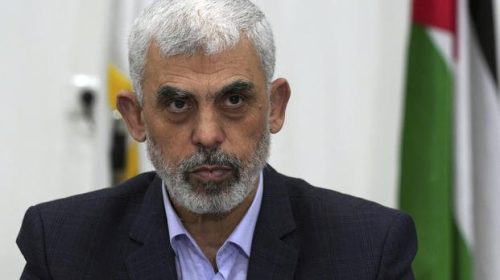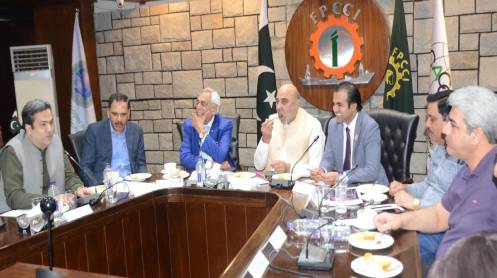The Israeli military on Thursday announced the killing of Hamas leader Yahya Sinwar by its forces in southern Gaza the previous day.
The Israeli military “confirms that after a year-long pursuit, yesterday (Wednesday), October 16, 2024, IDF (military) soldiers from the Southern Command eliminated Yahya Sinwar, the leader of the Hamas organisation, in an operation in the southern Gaza Strip,” it said in a statement.
“The dozens of operations carried out by the IDF and the ISA (Shin Bet internal security agency) over the last year, and in recent weeks in the area where he was killed, restricted Yahya Sinwar’s operational movement as he was pursued by the forces and led to his elimination,” the military added.
Israel accuses Sinwar, 61, of being the mastermind of the October 7, 2023 attack on Israel that triggered the ongoing war, along with Hamas’s military chief Mohammed Deif.
The Israeli military has said Deif was targeted in a strike earlier this year though the Palestinian group has not confirmed it.
Sinwar in August replaced Hamas’s former chief Ismail Haniyeh, who was martyred in Iran on July 31. Israel has not commented on Haniyeh’s death.
The Hamas attack last year resulted in the deaths of 1,206 people on Israeli soil, most of them civilians, according to an AFP tally based on official Israeli figures that include hostages killed in captivity.
Israel’s retaliatory military offensive in Gaza has killed 42,438 people, a majority of them civilians, according to the Hamas-run territory’s health ministry. The UN acknowledges the figures to be reliable.
Hamas weakened, not crushed
Israel has been at war with Hamas since the October 7 attack, which resulted in the deaths of 1,206 people, mostly civilians, according to an AFP tally of official Israeli figures.
Israel’s retaliatory campaign in Gaza has killed 42,438 people, the majority civilians, according to data from the health ministry in the Hamas-run territory, which the UN considers reliable.
Israel has since expanded the scope of its operations to Lebanon, where Hamas ally Hezbollah opened a front against Israel by launching low-intensity cross-border strikes that forced tens of thousands of Israelis to flee their homes.
Netanyahu has vowed to battle Hezbollah until victory, and Israel on Thursday launched strikes on the south Lebanese city of Tyre, where the militant group and its allies hold sway.
Israel also issued evacuation warnings for civilians in parts of Lebanon’s eastern Bekaa Valley, a Hezbollah stronghold.
It had earlier struck a Hezbollah target in Syria, according to a war monitor, while Israel’s main ally the United States used heavy bombers to hit rebel targets in Yemen.
Tehran on October 1 conducted a missile strike on Israel, over which Israel has vowed to retaliate, sparking concern around the world that what is already a war on multiple fronts could morph into an all-out regional conflict.
Iran warning
Iran’s Revolutionary Guards chief Hossein Salami on Thursday warned Tehran would hit Israel “painfully” if it attacks Iranian targets.
The Syrian Observatory for Human Rights, a Britain-based monitor, said the Israeli raid on the Syrian city of Latakia targeted a “weapons depot belonging to Hezbollah”.
The Israeli military did not comment on the strike when contacted by AFP.
Israel has conducted hundreds of strikes in Syria in recent years, including multiple recent attacks along the Lebanese border that seek to cut off Hezbollah’s main weapons and equipment supply route from Iran to Lebanon.
In Huthi-controlled areas of Yemen, the United States conducted multiple B-2 bomber strikes on weapon storage facilities, according to the US military and defence department.
The Huthis’ political bureau said “the American aggression will not pass without a response”, and vowed to continue the group’s “support and assistance to Gaza and Lebanon”.
The war in Lebanon has left at least 1,373 people dead, according to an AFP tally of Lebanese health ministry figures, though the real toll is likely higher.
Israeli troops and Hezbollah fighters have been clashing near Lebanon’s southern border, where Hezbollah on Thursday said it hit four Israeli tanks with guided missiles.
Rescue workers affiliated with the Amal party, a Hezbollah ally, in the southern city of Qana were digging through the rubble of several buildings destroyed in strikes this week.
“More than 15 buildings have been completely destroyed, total destruction in a neighbourhood in Qana,” said Mohammed Nasrallah Ibrahim, one of the rescuers.
Israel has faced criticism over its strikes in Lebanon, including from its tops arms supplier the US.
Hunger in Gaza
In northern Gaza’s Jabalia, where almost the entire population is displaced, two hospitals said Israeli air strikes on a school sheltering displaced people killed at least 14 people.
The military reported that it had hit militants.
Some 345,000 Gazans face “catastrophic” levels of hunger this winter after aid deliveries fell, a UN-backed assessment said Thursday, warning of the persistent risk of famine.
Nearly 100 percent of Gaza’s population now lives in poverty, with a “staggering” unemployment rate of nearly 80 percent, the UN’s International Labour Organization said on Thursday.







